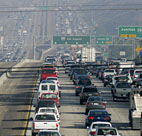 Written by Houston Business Journal
Written by Houston Business Journal
{Houston is one of 23 large metro areas in the United States facing an infrastructure challenge, according to an Urban Land Institute report released Tuesday.
ULI reports that Houston and other Sunbelt areas such as Atlanta, Dallas and Phoenix, "choke in suburban car dependence and a history of disconnected regional development just as driving becomes increasingly expensive."
Among the challenges facing these cities are expanding road capacity and retrofitting pedestrian-unfriendly subdivisions with mass transit, the report says.
The report shows that since 1980 vehicular travel in the United States has grown 95 percent, but road capacity has grown by only 4 percent. Los Angeles leads the largest cities with an average annual commute time of 72 hours in 2005, up from 45 hours in 1982. Houston's commute in 2005 was 56 hours a year on average, up from 30 hours in 1982.
ULI said Houston is focusing on controlling congestion and enabling mobility, and creating new transit methods such as the Light Rail.
"Houston expects traffic to double, but pins hopes on transit and highway funding to control congestion increases," the report says.
In terms of annual funding allocations for both transit and highway, ULI shows Houston spending less than $1 billion for short-term transit, almost $2 billion on long-term transit, and close to $3 billion each on short- and long-term highway projects.
However, the report warns that investing in transit isn't enough to fix the ailing infrastructure in "coreless metropolitan areas" such as Houston, Dallas and Phoenix.
Cities like Houston need to align transit projects with land use planning, or people will remain car-bound, the report suggests.
"Although transit budgets constitute about 50 percent of aggregate expenditures in long-range plans (approximately $610 billion), the expected share of transit commuting averages a measly 5.5 percent," the report says. "Although most plans seek behavioral changes in driving habits, they assume continued growth patterns toward the suburban edge, where car-dependent lifestyles predominate out of necessity."}

No comments:
Post a Comment